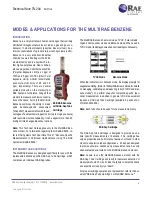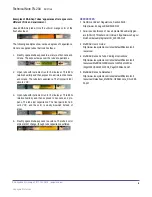
Technical Note TN-204
04/17/vk
2
Honeywell Internal
RAE Systems by Honeywell 877-723-2878 raesystems.com
Some measurable parameters of the instrument are presented be-
low. Refer to the MultiRAE Benzene datasheet for comprehensive
sensor specification data.
5
Sensor/Mode
Range
Reso-
lution
9.8eV for use in TVOC mode 10 ppb to 2,000 ppm
10 ppb
9.8eV for use in Benzene
mode (with RAE-Sep Tube
Cartridge)
0.1 to 200 ppm
0.1 ppm
MULTIRAE BENZENE-SPECIFIC MEASUREMENT
PRINCIPLE
In Benzene mode, the monitor is designed to make specific ben-
zene measurements. This is achieved via these two approaches:
1.
The monitor uses a lower-energy, 9.8eV PID lamp. This al-
lows excluding from cross-contamination all the VOCs with
ionization energy (IE) above 9.8eV.
2.
RAE-Sep tubes eliminate most VOCs. Two major effects
are present in them:
•
Gas absorption in the tube. This is usually a fast pro-
cess, and it is reversible.
•
Gas reaction (chemical) in the tube. This is a slower
process, and it is not reversible.
Note: Some VOCs can be eluted (removed) from the RAE-Sep
Tube and cause false positive benzene readings.
In addition, if the instruments are insensitive to some gases (for
example, their IE is above 9.8eV or if they require high correction
factors), the products of their chemical reactions in RAE-Sep
Tubes may become sensitive and may distort the benzene read-
ing. A separate case is when gases don’t absorb in the RAE-
Sep Tube and are insensitive to the monitor equipped with a
9.8eV lamp (for example, lower hydrocarbons such as methane,
ethane, etc.).
Example of Elution
When the instrument in Benzene mode was exposed to 400 ppm
of acetone for 60 seconds, the reading didn’t exceed 0.2 ppm.
After 5 minutes running in air, the reading increased and
reached almost 30 ppm.
Elution in Benzene mode with exposure to 400 ppm of
acetone.
Acetone didn’t convert in the RAE-Sep Tube within a short pe-
riod of time (slow chemical reaction) and further eluted with the
air stream.
Important: For the correct measurement and to avoid a false positive
response, RAE-Sep Tubes should be used just one time.
Humidity Effect
Humidity has no effect on the response to benzene. However,
high humidity affects the capacitance of the tubes to remove in-
terfering hydrocarbons, especially when they are in high con-
centrations.
The figure below shows the response of the instrument to the
mix of benzene (2 ppm) and octane (180 ppm). HPS-2 is the
case when the tube was opened and the instrument run with a
high pump speed (HPS) for about 5 minutes in ambient air with
relative humidity (RH) of 75 to 80% before a benzene measure-
ment in Benzene mode was done. HPS-1 is the case when ben-
zene measurements were done right after opening the tube.
Response of Benzene and Octane with different times of
measurement after opening the tubes, HPS-1 and HPS-2.
Each line represents a single tube, and each triangle repre-
sents a single measurement with that tube.
0
5000
10000
15000
20000
25000
30000
35000
0
10
20
30
Re
sp
on
se
, p
pb
Time, min
Acetone eluate from Sep-Tube
ppb
0
0.5
1
1.5
2
2.5
3
3.5
4
4.5
0
2
4
6
8
Re
ad
in
g,
p
pm
Numbers of measurements
Octane, response vs. numbers
of measurements
HPS-1
HPS-2




